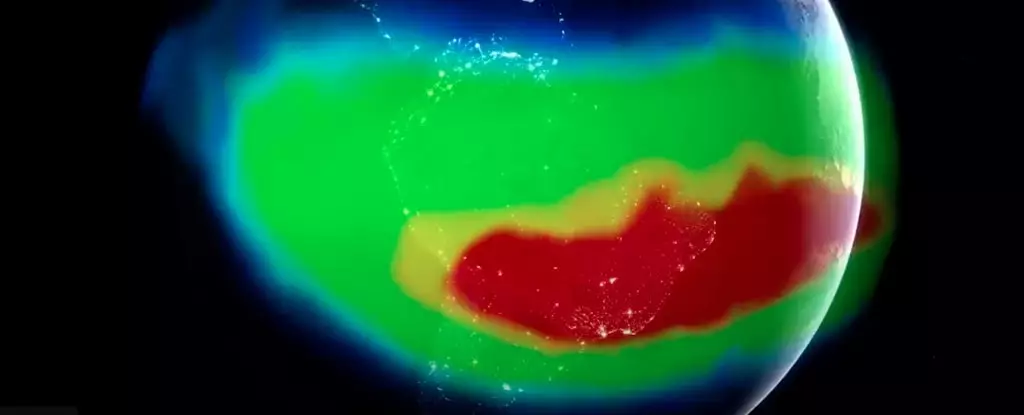The enigmatic South Atlantic Anomaly (SAA) has stirred both curiosity and concern among scientists, particularly within NASA. This peculiar phenomenon manifests as a significant reduction in the Earth’s magnetic field strength over a vast area that stretches from South America to southwestern Africa. While this anomaly presents limited risks to life on Earth, it poses substantial threats to spacecraft and satellites operating in low-Earth orbit. As we delve into the intricacies of the SAA, its implications, and ongoing research, it becomes clear that understanding this anomaly is vital for the future of space exploration and technology.
The SAA is often described metaphorically as a “dent” or a “pothole” in the Earth’s magnetic shield, reflecting its irregular magnetic field. This weakened magnetic intensity means that satellites traversing this region experience an increase in exposure to high-energy solar particles. NASA has observed that during these flyovers, onboard systems may encounter short-circuits or malfunctions. While many of these incidents result in minor glitches, there exists a risk of severe data loss or irreparable damage to critical components onboard. Consequently, satellite operators must proactively manage these risks by preemptively shutting down certain systems before entering the anomaly.
This delicate balance of risk and management highlights why NASA prioritizes monitoring the SAA. The anomaly not only threatens technological infrastructures but also provides a unique opportunity for scientific investigation. As researchers study the anomaly’s characteristics, they gain insights into the complex processes governing Earth’s magnetic field.
According to experts, the primary source of Earth’s magnetic field originates from an ocean of molten iron located within the outer core. This dynamic mass generates electrical currents, which in turn produce the planet’s magnetic field. However, the field’s generation is not a straightforward phenomenon. One significant geological feature influencing the SAA is the African Large Low Shear Velocity Province, a substantial reservoir of dense rock situated around 2,900 kilometers below the surface. This geological anomaly appears to disrupt the magnetic field’s development, thereby contributing to the SAA’s weakened state.
Geophysicist Weijia Kuang from NASA’s Goddard Space Flight Center suggests that the weakening dipole field in the anomaly region may be a consequence of localized magnetic disturbances. A particularly interesting aspect is the emergence of areas within the SAA that exhibit reversed polarity, further complicating its magnetic profile.
Recent studies have unveiled additional complexities of the SAA. Research led by NASA heliophysicist Ashley Greeley indicates that this magnetic anomaly is not static; it is in a continual state of motion. Analysis facilitated by CubeSats has confirmed that the SAA is gradually drifting, adding an intriguing layer to its characterization. Even more astonishing, scientists have observed that the SAA may be dividing into two distinct cells, each representing a separate center of magnetic weak intensity. This revelation introduces questions about the long-term implications of this division and whether it relates to broader geological phenomena.
Importantly, findings indicate that the South Atlantic Anomaly is not a recent occurrence but rather a recurrent phenomenon that may have affected the Earth’s magnetic dynamics for millions of years. A pivotal study published in July 2020 theorizes that the SAA could have been present for approximately 11 million years, suggesting that it might not be an indicator of an imminent shift in the planet’s magnetic field—a process that typically unfolds over extensive time frames.
As researchers grapple with the complexities of the SAA, the emphasis on continuous observation is paramount. With the ongoing changes in its morphology, there is a compelling call for further missions dedicated to tracking this anomaly. The knowledge gained from such research not only informs the scientific community but also enhances the safety measures for orbital missions.
Understanding the South Atlantic Anomaly serves as a reminder of the vastness and unpredictability of Earth’s systems. While the anomaly may not present an immediate threat to life on the planet, its implications for technology and ongoing scientific exploration are profound. As NASA continues to monitor this magnetic oddity, our understanding of Earth’s magnetic dynamics—and potentially our broader geophysical environment—will undoubtedly grow.
The investigation of the South Atlantic Anomaly is more than just an academic pursuit. It embodies a vital intersection of curiosity, risk management, and technological advancement, underscoring the critical role of continued observational missions in unraveling the mysteries of our planet.

